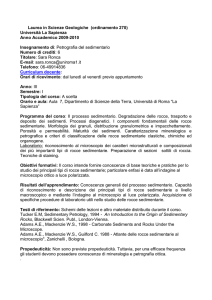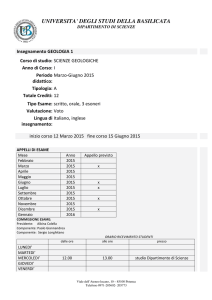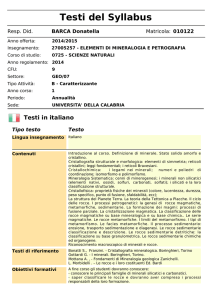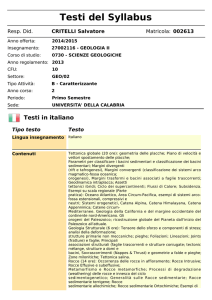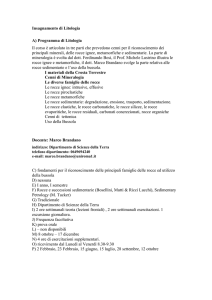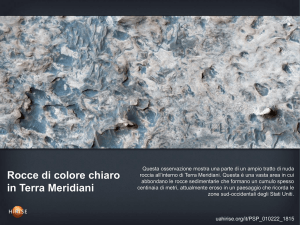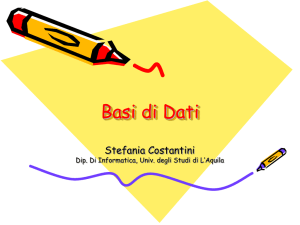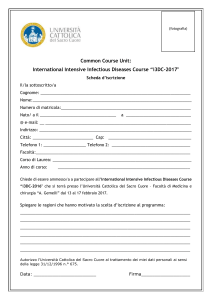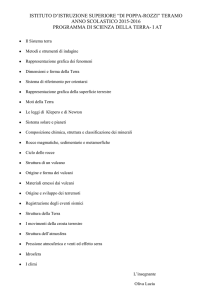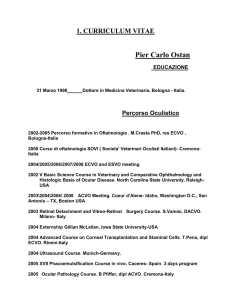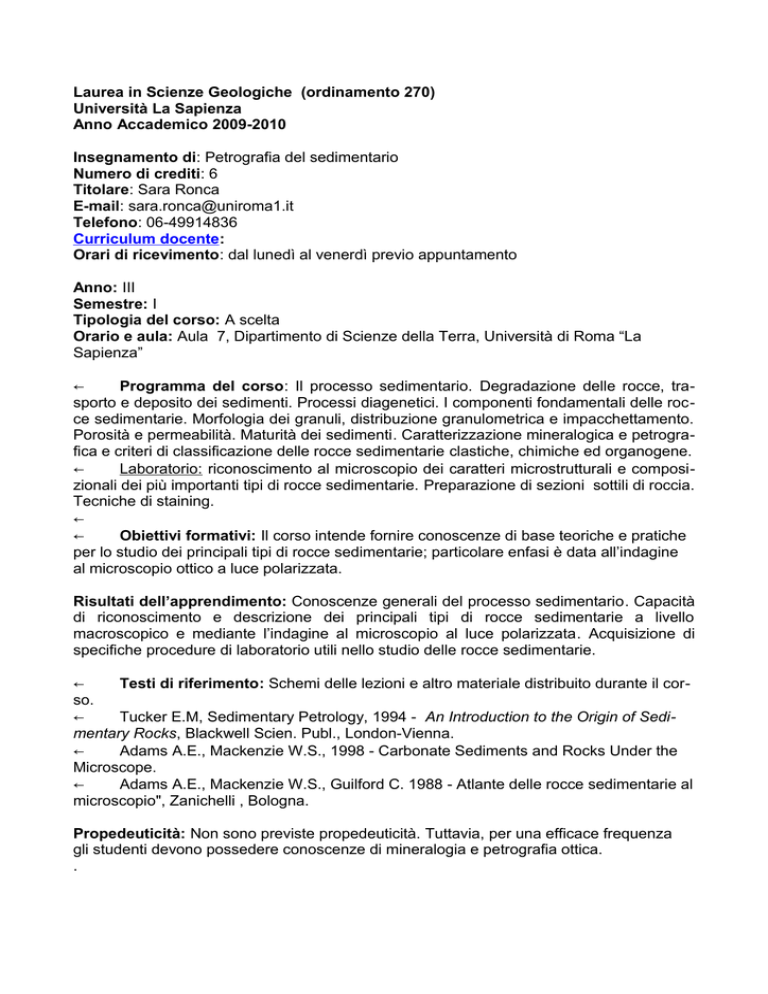
Laurea in Scienze Geologiche (ordinamento 270)
Università La Sapienza
Anno Accademico 2009-2010
Insegnamento di: Petrografia del sedimentario
Numero di crediti: 6
Titolare: Sara Ronca
E-mail: [email protected]
Telefono: 06-49914836
Curriculum docente:
Orari di ricevimento: dal lunedì al venerdì previo appuntamento
Anno: III
Semestre: I
Tipologia del corso: A scelta
Orario e aula: Aula 7, Dipartimento di Scienze della Terra, Università di Roma “La
Sapienza”
←
Programma del corso: Il processo sedimentario. Degradazione delle rocce, trasporto e deposito dei sedimenti. Processi diagenetici. I componenti fondamentali delle rocce sedimentarie. Morfologia dei granuli, distribuzione granulometrica e impacchettamento.
Porosità e permeabilità. Maturità dei sedimenti. Caratterizzazione mineralogica e petrografica e criteri di classificazione delle rocce sedimentarie clastiche, chimiche ed organogene.
←
Laboratorio: riconoscimento al microscopio dei caratteri microstrutturali e composizionali dei più importanti tipi di rocce sedimentarie. Preparazione di sezioni sottili di roccia.
Tecniche di staining.
←
←
Obiettivi formativi: Il corso intende fornire conoscenze di base teoriche e pratiche
per lo studio dei principali tipi di rocce sedimentarie; particolare enfasi è data all’indagine
al microscopio ottico a luce polarizzata.
Risultati dell’apprendimento: Conoscenze generali del processo sedimentario. Capacità
di riconoscimento e descrizione dei principali tipi di rocce sedimentarie a livello
macroscopico e mediante l’indagine al microscopio al luce polarizzata. Acquisizione di
specifiche procedure di laboratorio utili nello studio delle rocce sedimentarie.
←
Testi di riferimento: Schemi delle lezioni e altro materiale distribuito durante il corso.
←
Tucker E.M, Sedimentary Petrology, 1994 - An Introduction to the Origin of Sedimentary Rocks, Blackwell Scien. Publ., London-Vienna.
←
Adams A.E., Mackenzie W.S., 1998 - Carbonate Sediments and Rocks Under the
Microscope.
←
Adams A.E., Mackenzie W.S., Guilford C. 1988 - Atlante delle rocce sedimentarie al
microscopio", Zanichelli , Bologna.
Propedeuticità: Non sono previste propedeuticità. Tuttavia, per una efficace frequenza
gli studenti devono possedere conoscenze di mineralogia e petrografia ottica.
.
Modalità di erogazione:
Erogazione
Dato expresso in
ORE
Lezioni
24
Esercitazi Laboratori
oni
Studio
assistito
36
Studio
individuale
Terreno
Totale
ore
60
Frequenza: facoltativa ma fortemente consigliata
←
Metodi di valutazione: Valutazione finale espressa in trentesimi. Esame individuale consistente in una prova pratica (descrizione microscopica di sezioni sottili di rocce sedimentarie e relativa classificazione) e discussione orale dell'elaborato.
←
Appelli: Le date degli appelli saranno rese note agli studenti all’inizio del corso
Dati statistici relativi alle votazioni d'esame conseguite dagli studenti: non disponibili,
essendo un insegnamento di nuova istituzione.
←
Date di inizio e termine e calendario delle attività didattiche: sarà stabilito dal
CAD di Scienze Geologiche e reso noto prima dell’inizio del I semestre.
Bachelor of Science in Geology
La Sapienza University
Academic Year 2009-2010
Title of course: Sedimentary petrography
Number of Credits: 6
Course teacher: Sara Ronca.
E-mail: [email protected]
Phone: 06-49914836
CV Sara Ronca
Contact hours for students: mon-fry by appointment
Year of Course: III
Semester: I
Type of Course: optional course
Course Location: Classroom 7 , Earth Sciences Department, Università di Roma “La
Sapienza”
Course Subject:
Origin of sedimentary rocks. Weathering of rocks, trasport and deposition of sediments.
Diagenetic processes. Sedimentary environments and facies. Fundamental components of
sedimentary rocks. Grain morphology, grain-size distribution, packing. Porosity and
Permeability in Sedimentary Rocks. Sediment maturity. Mineralogy, petrography,
geochemistry and classification of the clastic, chemical and biogenic sedimentary rocks.
Laboratory work emphasize the study of the sedimentary rocks in thin section. Other topics
are thin and polished section preparation and staining techniques.
Course Aims: The purpose of this course is to provide students with basic knowledge and
skills for the description, classification and genetic interpretation of the sedimentary rocks.
Special emphasis will be on the analysis and description of sedimentary rocks under
polarizing microscope.
Learning Outcomes:
Knowledge and Understanding: On successful completion of the course, students
should: be able to understand basic principles of the genesis of sedimentary rocks, and
classification criteria; be able to explain the sedimentary processes that produce various
types of sedimentary rocks; be able to identify and explain the products and processes of
diagenesis.
Skills and Attributes: On successful completion of the course students should: be able to
describe, identify, and interpret minerals and sedimentary rocks using polarizing microscope and explain genetic processes that led to their formation; be familiar with a number of
laboratory techniques used in the study of sedimentary rocks
Suggested Reading List: Lecture notes and powerpoint files of lectures.
Tucker E.M, Sedimentary Petrology, 1994 - An Introduction to the Origin of Sedimentary
Rocks, Blackwell Scien. Publ., London-Vienna.
←
Adams A.E., Mackenzie W.S., 1998 - Carbonate Sediments and Rocks Under the
Microscope.
←
Adams A.E., Mackenzie W.S., Guilford C. 1988 - Atlante delle rocce sedimentarie al
microscopio", Zanichelli , Bologna.
←
.
Prerequisites: There are no formal prerequisites for this course, but students should be
familiar with the petrographic microscope and be able to identify the most common rock
forming minerals with this instrument.
Assessment method: practical (detailed technical description of a sedimentary rock in
thin-section) and oral examination.
Delivery Mode:
Delivery Mode
Lecture
Classroom-based
datum expressed
in HOURS
24
Practical
Workshop
Guided
Learning
Independent
Fieldwork Total
36
hours
60
Course attendance: Course attendance is not mandatory, but strongly encouraged.
Examination dates. Will be communicated to students at the beginnin of the course
Statistical data on exam grades: Not available, as the course is not yet activated
Duration of teaching activities (semester-based): not yet established.
CV Sara Ronca
Academic position - 1999 to present, Full-time researcher in Petrography and petrology –
Earth Sciences Dept.- Faculty of Mathematical, Physical and Natural Sciences - University
of Rome “La Sapienza”
Education - Oct. 1996, PhD in Earth Sciences, Dissertation: “Petrology of the Latehercynian dyke magmatism from Sarrabus (South-eastern Sardina – Italy)”. 1991-1995,
PhD course in Earth Sciences , University of Perugia. Dec.1990, Degree in Geology (with
distinction), University of Perugia” (Italy). Thesis: “Recent magmatic activity along the Mt.
Martani fault (Umbria-Italy) – geologic and petrologic study”.
Training/separate courses - II School of Petrography "Methods and modelling in the
modern igneous petrology” – Gruppo nazionale di petrografia , Asiago (June 1998);
Course "Il deterioramento e la conservazione dei materiali lapidei e litoidi” Architecture
Istitute - University of Venice (Italy) (September 1994;, Course "Carbonatites and
associated alkaline and phenitic rocks" held by Woolley A. – University of Perugia (June
1994). Visiting researcher at the CNR Geochronology and isotopic geochemistry istitute of
Pisa – research topics: Rb-Sr mineral age determinations and Sr and Nd isotope
geochemistry on the Late-hercynian dyke magmatism of Sarrabus (Apr-Aug 1993). VI
Summer School of Earth and Planetary Sciences: "Radiometric age determinations in
orogenic processes - potential and limits” (June 1992). “Geochronology and Isotope
geochemistry school” – Geochronology and isotope geochemistry Istitute – Italian National
Research Council (June 1992).
Teaching - University of Rome “La Sapienza” Faculty of Mathematical, Physical and
Natural Sciences
Bsc Geology: Instrumental Analyses of Rocks (Fall 2003-2009); Introduction to
petrography (Fall 2004 and Fall 2007); Petrography and laboratory of petrography (Fall
2007). Master ‘s Degree in Georesources: Regional petrography (Fall 2006-2008);
Cristalline rock petrography (Fall 2006-2008). Bsc in Sciences applied to Cultural heritage:
Cultural heritage materials (Fall 2008-2009).
Research interest - Alkaline-carbonatitic magmatism of Brazil; Late to post-Hercynian
dyke magmatism of the Sardinia-Corsica domain; Meso-Cenozoic Basaltic magmatism of
Egypt; Alkaline ring complex magmatism of Egypt.

